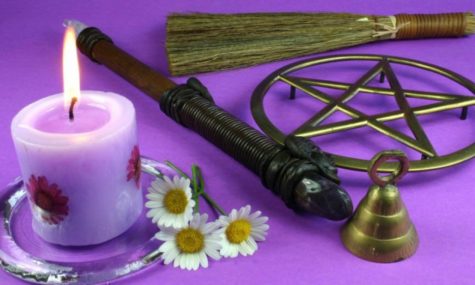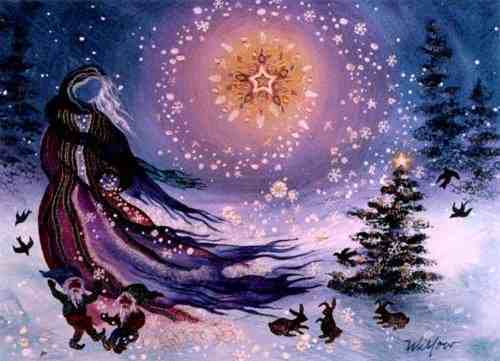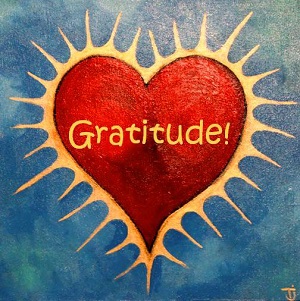Many just beginning their studies of Magick think that there is only one Witchcraft, that being Wicca.
Why magick and not magic? The answer is quite simple…magic is what Copperfield and other illusionists perform. Magick is true, not an illusion. I will never forget the intense surge of power I felt vibrating in my body the first time I practiced magick, and I get that same feeling every time.
I believe it is important for beginners to realize that their are many more paths one can follow. By learning about different ones, it can not only enrich your knowledge, but even guide you towards a path that’s best suited for you. It is common for people use the terms Witchcraft and Wicca interchangeably. Whether they are different or just a way of describing the same thing depends on which Witch you ask. Either way you look at it, there is more than one path or tradition. The following are just a few descriptions of some of the most common.
Alexandrian:
Founded in England during the 1960’s by Alexander Sanders, self-proclaimed “King of the Witches”. An offshoot of Gardnerian, Alexandrian covens focus strongly upon training, emphasizing on areas more generally associated with ceremonial magic, such as Qabalah, Angelic Magic and Enochian. The typical Alexandrian coven has a hierarchical structure, and generally meets on weekly, or at least on Full Moons, New Moons and Sabbats. Rituals are usually done skyclad.
Most Alexandrian covens will allow non-initiates to attend circles, usually as a “neophyte,” who undergoes basic training in circle craft prior to being accepted for the 1st degree initiation. Alexandrian Wicca uses essentially the same tools and rituals as Gardnerian Wicca, though in some cases, the tools are used differently, and the rituals have been adapted. Another frequent change is to be found in the names of deities and guardians of the Quarters. In some ways these differences are merely cosmetic, but in others, there are fundamental differences in philosophy. Over the last 30 years, the two traditions have moved slowly towards each other, and the differences which marked lines of demarcation are slowly fading away.
Celtic:
The Celtic path is really many traditions under the general heading of “Celtic.” It encompasses Druidism, Celtic Shamanism, Celtic Wicca or Witta, the Grail Religion, and Celtic Christianity or Culdees. Each path is unique and stand alone meld together with another and still be part of the Celtic tradition. It is primarily derived from the ancient pre Christian Celtic religion of Gaul and the British Isles.
As it is practiced today, most of the Celtic paths are part of the Neo-Pagan revival, focusing on Nature and healing with group and individual rituals that honor the Ancient Shining Ones and the Earth. Most are very eclectic, and hold to the Celtic myths, divinities, magic and rituals. Celtic paths are some of the more popular traditions.
Ceremonial:
Uses a great deal of Ceremonial Magick in practices. Mostly derived from the works of Aleister Crowley. Detailed rituals with a flavor of Egyptian magick are popular, as Qabalistic ritual forms.
Chaos:
Chaos magic theory says that belief is an active magical force. It emphasizes flexibility of belief and the ability to consciously choose one’s beliefs, hoping to apply belief as a tool rather than seeing it as a relatively unchanging part of one’s personality. Various psychological techniques are employed in order to induce flexibility of belief. Other chaos magicians suggest that people do not need belief to work magic. Austin Osman Spare asserts in The Book of Pleasure and various other works that will formulates desire which promulgates belief.
Chaos magic was first formulated in West Yorkshire, England in the 1970s. A meeting between Peter J. Carroll and Ray Sherwin in Deptford in 1976 has been claimed as the point of emergence of chaos magic, and in 1978 Carroll and Sherwin founded the Illuminates of Thanateros, a chaos magic organization. The Book of Results is the first book dedicated to the subject of sigilisation and The Theatre of Magick in which Chaos as a separate discipline was first mentioned.
Visionary artist and mystic Austin Osman Spare, who was briefly a member of Aleister Crowley’s A∴A∴ but later broke with them to work independently, is largely the source of chaos magical theory and practice. Specifically, Spare developed the use of sigils and the use of gnosis to empower these. Most basic sigil work recapitulates Spare’s technique, including the construction of a phrase detailing the magical intent, the elimination of duplicate letters, and the artistic recombination of the remaining letters to form the sigil. Although Spare died before chaos magick emerged, many consider him to be the father of chaos magic because of his repudiation of traditional magical systems in favor of a technique based on gnosis.
Dianic:
This is the most feminist Craft Tradition. Most Dianic covens worship the Goddess exclusively (Diana and Artemis are the most common manifestations) and most today are women only. Rituals are eclectic; some are derived from Gardnerian and Faery traditions, while others have been created anew. Emphasis is on rediscovering and reclaiming female power and divinity, consciousness-raising, and combining politics with spirituality. The Dianic Craft included two distinct branches:
The first Dianic coven in the U.S. was formed in the late ’60s by Margan McFarland and Mark Roberts, in Dallas, Texas. This branch gives primacy to the Goddess in its theology, but honors the Horned God as Her beloved Consort. Covens include both women and men. This branch is sometimes called ‘Old Dianic,’ and there are still covens of this tradition specially in Texas. Other coven, similar in theology but not directly descended from the McFarland/Roberts line are sprinkled around the country.
The other branch, Feminist Dianic Witchcraft, focuses exclusively on the Goddess and consists of women-only covens, often with a strong lesbian presence. These tend to be loosely structured and non-hierarchical, using consensus decision making and simple, creative, experimental ritual. They are politically feminist groups, usually very supportive, personal and emotionally intimate. The major network is Re-Formed Congregation of the Goddess. Z Budapest founded the Susan B. Anthony Coven in 1971, declaring Dianic Witchcraft to be “Wimmin’s Religion”. The Women’s Spirituality Forum was Founded by Z Budapest in 1986, and is dedicated to bringing Goddess consciousness to the mainstream of feminist consciousness through lectures and, retreats, classes, cable TV shows, and rituals in the effort to achieve spiritual and social liberation.
Draconic Wicca:
Draconic Wicca is the utilization of the powers of the dragons. There are as many dragons as there are people. They are as varied as humans are also. We work with these dragons to achieve the results that we seek. In doing so, we have to deal with the unique personalities of each type of dragon. The dragons have no real hierarchy other than age, except for the case of The Dragon. The Dragon is the combined powers of the God and the Goddess. The Dragon is invoked or evoked during Sabbats and in times when great magick is needed (not when you can not find your keys). Invoking means to call into you the power of the dragon that you name i.e. a fire dragon. You ask that this dragon assume himself/herself into your spiritual body. To evoke means to call a dragon to you, to join you in your magickal workings.
Eclectic:
Refers to groups and individuals who do not fully adhere to one specific form of Paganism. They choose to incorporate some beliefs, practices, rituals etc, of a few, or many paths to form a unique one that suits their spiritual needs. Gypsy magic tends to fall into this category.
Faery/Faerie/Fairy/Feri:
Victor and Cora Anderson are the original teachers of the Feri Tradition. Victor is universally recognized as the Grand Master of his order of Feri. He was initiated in 1926 by a priestess from Africa. He is also one of the last genuine Kahuna. His book of poetry, Thorns of the Blood Rose, is considered a contemporary Pagan classic.
In 1959, Victor initiated the late Gwydion Pendderwen (age 13 at the time), who later became a leading voice in the Feri Tradition. Gwydion concentrated on the Welsh Celtic aspects; whereas Victor and Cora still practice the tradition as it was originally, with Huna and African diasporic influences, primarily Dahomean-Haitian. The Feri Tradition honors the Goddess and Her son, brother and lover (The Divine Twins) as the primary creative forces in the universe. The Gods are seen as real spirit beings like ourselves, not merely aspects of our psyche.
It is an ecstatic, rather than fertility tradition, emphasizing on polytheism, practical magic, self-development and theurgy. Strong emphasis is placed on sensual experience and awareness,including sexual mysticism, which is not limited to heterosexual expression. This is a mystery tradition of power, mystery, danger, ecstasy, and direct communication with divinity. Most initiates are in the arts and incorporate their own poetry, music and invocations into rituals.
The Tradition is gender-equal, and all sexual orientations seem able to find a niche. According to Francesca De Grandis, founder of the 3rd Road branch: “Faerie power is not about a liturgy but about one’s body: a Fey shaman’s blood and bones are made of stars and Faerie dust. A legitimate branch of Faerie is about a personal vision that is the Fey Folks’ gift to a shaman.”
Initially small and secretive, many of the fundamentals of the Tradition have reached a large audience trough the writings of Starhawk, the most famous initiate. Some secret branches remain. While only a few hundred initiates can trace their lineage directly to Victor Anderson, many thousands are estimated to practice neo-Faery Traditions.
Gardnerian:
This is a closed initiatory Tradition which was founded in England ca 1953 by Gerald Gardner and further developed by Doreen Valiente and others. Gardner was initiated into a coven of Witches in the New Forest region of England in 1939 by a High Priestess named ‘Old Dorothy’ Clutterbuck. In 1949 he wrote High Magic’s Aid, a novel about medieval Witchcraft in which quite a bit of the Craft as practiced by the coven was used.
In 1951 the last of the English laws against Witchcraft were repealed (primarily due to to the pressure of Spiritualists) and Gardner published Witchcraft Today, which set forth a version of rituals and traditions of that coven.
Gardner gave his Tradition a ritual framework strongly influenced by Freemasonry and Crowleyan ceremonial magic, as well as traditional folk magic and Tantric Hinduism. The Tradition was brought to the USA in 1965 by Raymond & Rosemary Buckland, who were initiated in 1964 by the Gardner’s High Priestess, Lady Olwen.
Gardnerian covens are always headed by a High Priestess and have three degrees of initiation closely paralleling the Masonic degrees. Worship is centered on the Goddess and the Horned God. The tradition emphasizes polarity in all things, fertility, and the cycle of birth-death-rebirth. Eight seasonal Sabbats are observed, and the Wiccan Rede is the guiding principle. Power is raised through scourging and sex magick (“The Great Rite”), as well as meditation, chanting, astral projection, dancing, wine and cords. Designed for group/coven work, through solitary workings have been created. Covens work skyclad.
Shamanic Witchcraft:
This term refers to practices associated with those of tribal shamans in traditional Pagan cultures throughout the world. A shaman combines the roles of healer, priest (ess), diviner, magician, teacher and spirit guide, utilizing altered states of consciousness to produce and control psychic phenomena and travel to and from the spirit realm. Followers of this path believe that historical Witchcraft was the shamanic practice of European Pagans; and Medieval Witches actually functioned more as village shamans than as priests and priestesses of :the Old Religion.”
Shamanic Witchcraft emphasizes serving the wider community through rituals, herbalism, spell craft, healings, counseling, rites of passage, handfastings, Mystery initiations, etc. The distinguishing element of Shamanic Witchcraft is the knowledge and sacramental use of psychotropic plants to effect transitions between worlds. The theory and practice of Shamanic Witchcraft has permeated widely though out many other established Traditions.
Stregheria:
Stregheria is the form of witchcraft native to Italy; there are several distinct traditions sharing common roots, in various parts of Italy. Also called, La Vecchia Religione, Stregheria is a nature-based religion, it’s followers worship the forces of Nature, personified as gods and goddesses. The witches of La Vecchia Religione are called Streghe (plural), with the title Strega (for a female), Stregone (for a male).
Stregheria is rooted in the folk religion of the Latins (the Romans being one Latin people) and the Etruscans. In the particular tradition, taught by Raven Grimassi in Ways of the Strega, the pantheon is different from the urban gods of the Romans, though some of those deities were shared with the Latins, and the Etruscans, most notably Diana, whose worship was focused at a temple at Lake Nemi in the Alban Hills. There are however other traditions of Stregheria in Italy, who may worship the urban gods of the Romans.
The particular tradition taught by Raven Grimassi in Ways of the Strega, is derived from a renewal that occurred in the 14th century brought about by a wise woman from Tuscany called Aradia. This does not imply that witchcraft in Italy began in the 14th century. La Vecchia Religione is an evolution of pre-christian religions in Italy. The tradition taught by Aradia was a revival of the Old Ways during a time of extreme persecution of the peasants of Italy.
Wiccan Shamanism:
Founded by Selena Fox in the 1980’s. Ecumenical and multicultural focus. Combination of Wicca, humanistic psychology and a variety of shamanistic practices from around the world. Emphasis on healing. Uses traditional shamanistic techniques to change consciousness, such as drumming and ecstatic dancing.
- Invocation to the Archangels as a Group by shirleytwofeathers - No Comment
- Invocation to Lord Melchizedek by shirleytwofeathers - No Comment
- Connecting with Fairies by shirleytwofeathers - No Comment
- To Enhance Clairvoyance by shirleytwofeathers - No Comment
- For Release of Addictions and Cravings by shirleytwofeathers - No Comment
- Using the Psalms for Solving Problems by shirleytwofeathers - 148 Comments
- Spiritual Assistance Spell by shirleytwofeathers - 35 Comments
- 62 Spells To Defeat Your Enemies by shirleytwofeathers - 27 Comments
- Once In A Blue Moon Spell by shirleytwofeathers - 24 Comments
- Spell To Find A Lost Pet by shirleytwofeathers - 12 Comments
Mauro: Ritual To Become A Werewolf
Mauro: Becoming A Werewolf Ritual
Janet Silva: Wheel of Fortune Change Your Luck Spell
Linda: Sweet Thoughts Bottle Spell
AnnD: Chant For Guidance




